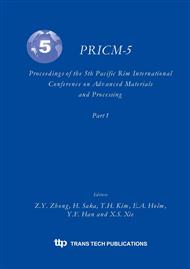p.1073
p.1077
p.1083
p.1087
p.1091
p.1097
p.1101
p.1105
p.1109
Tensile and Bending Behavior of Melt Growth Al2O3/YAG Composite at Ultra High Temperatures (1773-2023K)
Abstract:
The deformation and fracture behavior at 1773-2023K of the unidirectionally solidified eutectic Al2O3/YAG (Yttrium-Aluminum Garnet with the composition of Y3Al5O13) ceramic composite was investigated. The stress-stain curve and strength of unnotched and notched specimens, measured by bending and tensile tests, showed that (a) both unnotched and notched specimens fractured in a brittle manner at low temperatures and at high displacement speeds, but in a ductile manner at high temperatures and at low displacement speeds, and (b) the notched strength increased, reaching maximum, and decreased with increasing temperature and decreasing displacement speed. The increase in the notched strength with increasing temperature and decreasing displacement speed up to the maximum value was accounted for by the increase in plastic zone size ahead of the notch, and the decrease with further increasing temperature and decreasing displacement speed by the loss of the stress carrying capacity of the yielded ligament, based on the finite element analysis.
Info:
Periodical:
Pages:
1091-1096
Citation:
Online since:
January 2005
Price:
Сopyright:
© 2005 Trans Tech Publications Ltd. All Rights Reserved
Share:
Citation:


